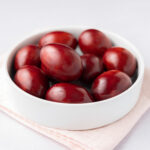
How to Dye Eggs Red Naturally
Learn how to simply and naturally dye eggs red using onion skins! This is a perfect non-toxic option for Greek Easter and Chinese birthday celebrations.
Servings 12 eggs
Calories 78kcal
Ingredients
- 5 cups water
- 2 tablespoons vinegar
- onion skins from 14-16 large onions a mix of yellow and red
- 12 eggs
Instructions
- Add water, vinegar, and onion skins to a wide saucepan. Stir together. (See notes)*
- Bring to a boil, cover, and reduce to simmer for 30 minutes. Remove from heat, uncover, and let cool for another 30 minutes. While the dye cools, carefully wipe the eggs with a wet cloth to remove any dirt or anything that's clinging to the shell (See notes)*
- Add the eggs in a single layer, carefully placing them in between the onion skins (you may need to remove some of the skins to make room, which is fine. If the eggs aren’t completely submerged in the dye, add in a cup of cold water.
- Bring to a boil, then cover and reduce to simmer for 8 minutes.
- Remove from heat and let cool on the counter for 1-2 hours, uncovered, checking periodically to see if the eggs have reached your desired shade of red. Move to fridge overnight if the color isn’t to your preference (I left mine in the fridge for about 16 hours to achieve the deep red color shown in the photos).
- Using a slotted spoon, carefully move eggs to a plate or rack and let air dry. (See notes)*
- Lightly polish with olive oil (or any edible oil) to give it shine.
- Keep stored in the fridge until ready to use (they can be kept about a week).
Notes
- Use a wide enough saucepan where the eggs will be able to be placed in a single layer (a 3qt or 4qt saucepan should work great).
- Once the dye has cooled for 30 minutes, you have the option to strain the onion skins and place the dye back in the saucepan. I like leaving the onion skins in because they can add a bit of an imperfect design to the eggs during the dying process.
- If using a plate to dye the eggs, you may need to rotate the eggs from time to time to thoroughly dry them all around. Make sure there isn't a puddle of watery dye on the plate during the drying process. Once the eggs are mostly dried, you can take a paper towel to lightly dab the eggs to finish drying (a small amount of the dye may rub off but that's normal).
Nutrition
Serving: 1g | Calories: 78kcal | Carbohydrates: 1g | Protein: 6g | Fat: 5g | Saturated Fat: 2g | Cholesterol: 187mg | Sodium: 67mg | Potassium: 63mg | Sugar: 1g | Vitamin A: 260IU | Calcium: 28mg | Iron: 1mg